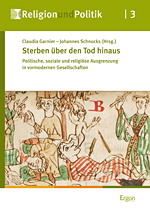Dying beyond death

This book explores political, social and religious forms of exclusions on premodern societies. In premodern societies persons were not recognized as being really alive but for their relations to other people. Accordingly, the isolation from a community meant a decrease in life and existence. Exclusion could go as far as declaring those who were cut off dead. This concept is based on the perception that death is not only a biological phenomenon but is also determined by the cultural practices of a society. Man dies biologically as a physical individual, and at the same time he dies as a member of a social community. Biological and social death may be coincidental, but they may also be separated. This means that also those still alive biologically can be treated as if already dead by severing all ties with them. Against this background of cultural anthropology the book explores forms of exclusion, which were employed as sanctions for breaches of the social code. The contributions take into view political, social and religious aims of this exclusion, shedding light on it from an interdisciplinary angle. They range from the analysis of ancient oriental sources and texts from the Old Testament to a great variety of explorations of the question in medieval Europe. Emerging is a sometimes surprising number of correspondences and continuities which up to now have frequently been overlooked.
Literature: Garnier, Claudia, and Johannes Schnocks (eds.), Sterben über den Tod hinaus. Politische, soziale und religiöse Ausgrenzung in vormodernen Gesellschaften (Religion und Politik, vol. 3), Würzburg: Ergon 2012 (with contributions from Claudia Garnier, Regina Grundmann, and Johannes Schnocks).

